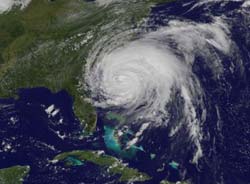NASA satellites catch many views of Hurricane Irene

This visible image of Hurricane Irene from the MODIS instrument aboard NASA's Terra satellite was taken at Aug. 26 at 12:30 p.m. EDT, when Hurricane Irene was off the Carolinas. Credit: NASA Goddard MODIS Rapid Response Team<br>
Coastal evacuations were already happening in New York City, coastal New Jersey, Delaware, Maryland, Virginia, and North and South Carolina.
NASA satellites gathered rainfall measurements and saw heavy rain and hot towering thunderstorms around Irene's center signaling the power behind her. Even on August 25, the Tropical Rainfall Measuring Mission (TRMM) satellite saw rainfall in intense bands of thunderstorms around her eye, that were dropping rainfall at 2 inches (50 mm) per hour.
NASA's Terra satellite captured a visible image of Hurricane Irene from the Moderate Resolution Imaging Spectroradiometer (MODIS) instrument on August 26 at 12:30 p.m. EDT, when Hurricane Irene was off the Carolinas. Although no eye was visible, Irene was still a Category 2 hurricane on the Saffir-Simpson scale and it was still at that intensity at 3:10 p.m. EDT.
NOAA's GOES-13 satellite provided a much broader view of Hurricane Irene against the entire U.S. east coast on August 26, 2011 at 1:40 p.m. EDT. The extent of Irene's 600 mile wide cloud cover was obvious as it stretched over a third of the U.S. east coast.
Residents along the eastern U.S. coast are facing hurricane-force winds and inland areas are facing tropical storm-force winds. At 2 p.m. EDT on August 26, tropical storm force winds have already arrived along the coast of the Carolinas. Hurricane Irene's center was located about 300 miles south-southwest of Cape Hatteras, North Carolina, near 31.2 North and 77.5 West. Its maximum sustained winds were near 100 mph and it was moving to the north near 14 mph. Minimum central pressure was 951 millibars.
Residents along the east coast need to heed watches and warnings and evacuations. Rainfall is a serious issue with Irene as she is expected to drop 6 to 10 inches with isolated amounts of 15 inches from eastern North Carolina into southeastern Virginia, eastern Maryland, Delaware, eastern Pennsylvania, New Jersey, southeastern New York, Long Island, Western Connecticut, and western Massachusetts through Monday morning.
The NHC said that dangerous storm surge levels as much as 11 feet are possible in the warning area in North Carolina, and up to 8 feet in southern portions of the Chesapeake Bay. The New Jersey shore can expect surges up to 6 feet above ground level.
Updated forecasts available through the NHC at http://www.nhc.noaa.gov/. Follow updates through the weekend from NASA Hurricane on Facebook and Twitter and at www.nasa.gov/hurricane.
Media Contact
More Information:
http://www.nasa.govAll latest news from the category: Earth Sciences
Earth Sciences (also referred to as Geosciences), which deals with basic issues surrounding our planet, plays a vital role in the area of energy and raw materials supply.
Earth Sciences comprises subjects such as geology, geography, geological informatics, paleontology, mineralogy, petrography, crystallography, geophysics, geodesy, glaciology, cartography, photogrammetry, meteorology and seismology, early-warning systems, earthquake research and polar research.
Newest articles

Properties of new materials for microchips
… can now be measured well. Reseachers of Delft University of Technology demonstrated measuring performance properties of ultrathin silicon membranes. Making ever smaller and more powerful chips requires new ultrathin…

Floating solar’s potential
… to support sustainable development by addressing climate, water, and energy goals holistically. A new study published this week in Nature Energy raises the potential for floating solar photovoltaics (FPV)…

Skyrmions move at record speeds
… a step towards the computing of the future. An international research team led by scientists from the CNRS1 has discovered that the magnetic nanobubbles2 known as skyrmions can be…




















